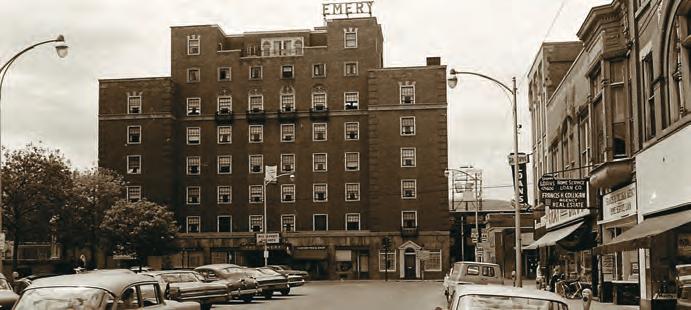
3 minute read
EMERY HOTEL THE LINK BETWEEN PITT-BRADFORD AND BRADFORD’S MILLIONAIRE ERA
The Emery Hotel played a brief, but memorable, part in Pitt-Bradford’s history.
The original luxury hotel was built by Grace Emery in memory of her millionaire father on the eve of the Great Depression.
Emery had spared no expense in building the top-of-the-line hotel.
The new hotel had seven stories and 105 guest rooms. From a telephone in every guest room to a mahogany baby grand piano in the lobby, Grace Emery’s vision was one of home and friendliness but wrapped in luxury.
A huge neon “Emery” sign on the roof lit up the night. A dark blue flag with the Emery family crest and the words “Fidelis et Suavis” or “Faithful and Courteous” flew from the balcony, and all 61 hotel employees, recently hired, were expected to honor that creed.
There was a barber shop with three barbers, an orchestrope phonograph on the seventh floor that held 26 records and could pipe music to every room and also be used as a paging system, a telephone switchboard, a cigar and newsstand, a laundry, and two elevators. An all-electric kitchen could serve 500 meals a day. Each room had its own toilet and washstand (unheard of in other Bradford hotels!) and either a bathtub or a shower.
The bellhops wore navy blue doublebreasted jackets with the name “Emery” embroidered in gold on the sleeve. The doorman wore a long blue overcoat with wide lapels and a military style hat with “E” written in gold braid.
There was a coffee house patterned after an old Early American tavern, and a main dining room. There were also five stores on the first floor, all of which faced the public square and three offices for professional men.
A private dining room, named the Venetian Room, featured a ceiling “finished with clouded effects embellished with blocks of various colors to harmonize with the large painting.” The large painting referred to was “Promenade in Venice,” a 19th-century life-size depiction of the Renaissance painter Paolo Veronese gliding through Venice in a gondola.
Painted by the Italian artist Tommaso Juglaris, the painting had been purchased by Grace Emery’s father, Pennsylvania State Sen. Lewis Emery, who traveled extensively and brought home eclectic items from around the world. Other items in his collection that were not relocated to the hotel included a Persian javelin inlaid with sliver, Egyptian vases from Alexan- dria, amber from Finland and the jawbone of a whale.

The Emery Hotel at the time Pitt-Bradford purchased it to become its first residence hall.
W. Forres Stewart collection
By the 1960s, however, modern motels were replacing traditional hotels. The Emery Hotel was sold to the University of Pittsburgh in May 1964. Interior renovations began immediately with anticipated completion in time for the fall semester. The new name would be Emery Hall.
As the renovations moved at breakneck speed, the lobby desk, glass display cases and large hotel safe were sold. Everything was painted, plumbing repaired or replaced, and new wiring installed.
The main portion of the former lobby became the Student Union, complete with comfortable chairs, a television, piano and tables for playing bridge or hearts. Gone was the Gold Room, which became a student bookstore. The Coffee Shoppe became the William Pitt Room, which was open seven days a week to area residents and visiting parents of collegians.
Dr. Donald Swarts, president of Pitt-Bradford and a refined art-lover himself, decided that Tommaso Juglaris’s masterwork “Promenade in Venice,” which had once hung in the Paris Salon, should be removed from the vicinity of any hijinks that might break out among the mildly mischievous students.
Swarts had the painting professionally crated and sent for safekeeping to a warehouse owned by a member of the university’s original advisory board, Carl E. Swanson, who had a contracting business. It would be 55 years before it was seen again.
The Emery Hotel at the time Pitt-Bradford purchased it to become its first residence hall.





